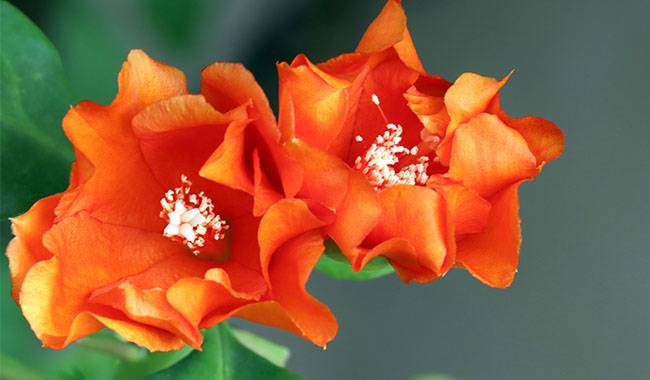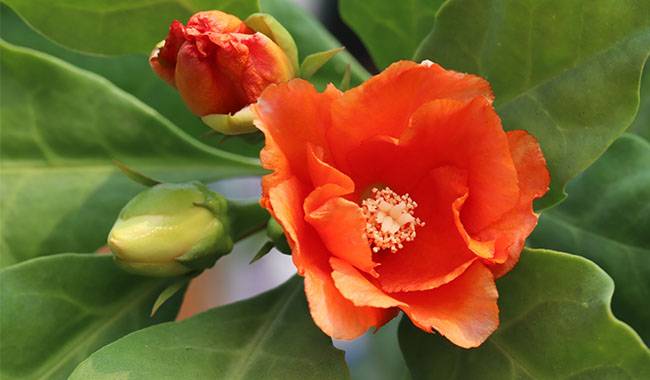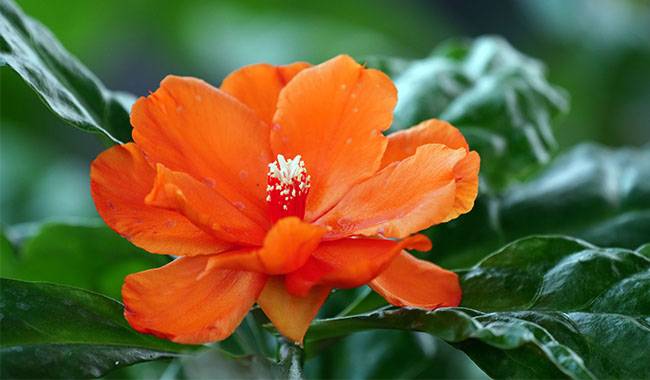
The status of the oldest cacti in Pereskia is controversial, but they are the most original. Unusual shrubs with real foliage and romantic flowers can hardly be mistaken for the usual indoor cacti relatives. The dangerous and beautiful prickles only emphasize how extravagant this plant is. Not the least of these, Pereskia can easily shed their legendary foliage. But still, they are easy-to-grow succulents that can easily add variety to a home collection. You will learn how to grow Pereskia plants in the ThumbGarden article.
PERESKIA PLANT DESCRIPTION
Representatives of the genus Pereskia are considered to be conflicting and almost the oldest cacti – unusually bright flowers, dangerous spines, and elegant leaves. They are classified in a special subfamily, Pereskioideae, and occur naturally only in Latin America. Pereskia is a small genus of about four species of cacti that do not look much like other types of cacti, with a large number of leaves and non-fleshy stems. The genus is named after the 16th-century French botanist Nicolas-Claude Fabri de Peiresc.
Pereskia is often used as a rhizome for other cactus species. In Brazil, you can enjoy their flower buds, leaves, and a special delicacy – aromatic, unusual, and delicious fruit known as Pereskia aculeata and lemongrass.
Pereskia is the unique cactus. These shrubs and woody plants can grow to great size in the wild and survive in the harshest conditions by storing water in their stems. But outwardly, they are closer to herbaceous plants – with deep roots and thin, branched, woody stems. Hidden in the axils are beautiful small pores with very large, sharp, tough prickles, singular or clustered, silvery or dark brown.
The true leaves are lance-shaped ovals with a pointed tip, similar to laurel. When up to 4 inches (10 cm) long, they are glossy and leathery, with varying shades of green among species and varieties. When uncomfortable and dormant, they shed and often fade.
The summer blooms are reminiscent of rosebuds and roses because of the delicate petals and large pistils surrounded by lush, hemispherical bright stamens. The flowers are 2 inches (5 cm) in diameter, solitary or clustered in inflorescences, fragrant, and have a delicate cream or pink color.
After flowering, edible, yellow-red fruit cones up to 1 inch (2.5 cm) in diameter begin to appear. Some fruit cones can compete with opuntia to form whole bunches of originals. As the fruit ripens, its hidden pores begin to swell, and new buds or side shoots grow as if the fruit were branched at the top.
TYPES OF INDOOR PERESKIA PLANTS
Pereskia orange (Pereskia bleo) is a plant with oval, large, wavy-edged frosted leaves and red-orange rose-like flowers that alternate with bright conical inedible fruits.
Pereskia aculeata is a climbing species that forms a very dense bush with large lance-shaped leaves and long prickly thorns. The shrub is scattered with rosehip-like, fragrant, broad, pale cream-colored flowers with bright orange stamens. There are quite a few forms and varieties with red leaves.
Pereskia Grandiflora is revered for its large, delicate pink flowers, accentuated by its dark foliage and very long spikes.
Pereskia weberiana is a very beautiful densely branched species that is easily formed. The snow-white flowers look particularly romantic with its small, bright oval leaves and abundant flowering period.
Pereskia grandifolia has the most exotic fruit with a bouquet on the fruit consisting of an ovary and a stem with intricately curved purple flowers.
GROWING CONDITIONS FOR INDOOR PERESKIA PLANTS

To avoid disappointment with this unusual cactus, it is worth taking the utmost care in choosing the conditions. As long as you provide the Pereskia with fresh air, the warmth it prefers, and bright light, you will not have maintenance problems.
Lighting and placement
Pereskia is one of the most photophilic cacti and does not like artificial light. They only bloom on a sunny windowsill. They can even be placed in a south-facing window. Direct summer sunlight often causes burns on the leaves, but this problem is easily remedied by simply removing them from the glass in the height of summer or by moving them to a position next to the window sill. The shrubs will stretch out and fail to bloom in the penumbra zone. Maintaining winter light levels and moving them to a bright windowsill is one of the requirements to keep overwintered plants from losing their leaves.
Temperature control and ventilation
Pereskia prefers fresh air. As long as the temperature does not rise suddenly and the plant does not bloom, ventilation is not a problem. Ventilate the room as much as possible. Pereskia should be placed outside in a warm, rainproof place whenever possible. In summer, Pereskia flowers grow well in warm conditions. When kept indoors, the temperature should ideally be kept between 70-73 °F (21-23 °C). Pereskia flowers can tolerate any heat outdoors or with constant ventilation. Pereski’s ideal overwintering temperature is around 59 °F (15 °C). Below 50 °F (10 °C), the temperature should not drop. Raising a familiar room temperature requires controlled light, frequent ventilation, and impeccable care.
CARING FOR PERESKIA PLANTS AT HOME

Careful watering, infrequent fertilization, and attention to detail are all measures Pereskia needs to maintain its ornamental qualities.
Watering and air humidity
For Pereskia, water is active only during the growing period, but even in winter, it is best not to let the substrate dry out completely, as Pereskia will drop its leaves in a drought. In spring and summer, allow the soil to dry out in the upper third of the pot, immediately draining excess soil from the tray. In winter, watering should be reduced. The humidity level should be changed gradually.
Although they do not like high humidity, it is best to include a “refreshing” spray of warm water when caring for them to maintain decorative foliage. The warmer the air temperature, the more frequently this should be done, up to daily in the summer. Dust is removed by washing the leaves; wiping will destroy the protective layer.
Fertilizer application and composition of fertilizer
Fertilizer should only be applied to this cactus in liquid form and only during the peak growth period. Monthly fertilization with a special succulent or cactus fertilizer is sufficient.
Pruning and shaping Pereskia
Even bonsai trees can be easily shaped into Pereskia. They are resistant to pruning in spring and summer, as long as at least 1-2 internodes are left on the shoots.
Repotting, containers, and substrates
Transplanting requires a very loose substrate with a pH of about 7.0. In a normal cactus and succulent mix, you should add 40-50% loose soil additive to ensure a high permeability (coarse sand, perlite, stone chips, gravel).
As soon as the roots fill the pot space, this cactus should be transplanted only as needed. Young cacti can be transplanted several times a year – older cacti often do not need to be “touched” for several years.
A deep enough container for transplanting corresponds to the unusually strong root system of the cactus. There must be a high drainage layer.
Pereskia does not tolerate root contact and should be transplanted with care. Watering after transplanting should be done with extreme caution until rapid growth begins.
Pereskia is one of the most susceptible cacti to overwatering and extremely susceptible to decay. Correct the condition and care immediately and initiate a fungicide treatment at the first sign of stem, root, or root damage. Emergency transplanting will most often result in death.
All dry-loving insects, such as spider mites, mealybugs, and thrips, are terrible pests of peppers. It is best to treat them immediately with an insecticide.
Leaves will become pale or droopy, and shoots will be elongated, indicating too much or not enough light. Irrigation problems most often cause growth disorders.
Propagation of Pereskia flowers
Growing Pereskia from seed is very difficult because it has a low germination rate, and the seedlings are very sensitive to any increase in moisture. Sow seeds to a depth of 0.4 inches (1 cm) in very light soil. At temperatures up to 68 °F (20 °C), the plants maintain light moisture under the canopy. Picking is done very carefully at the stage of 4 small leaves, but immediate sowing into individual containers is the best option.
At home, Pereskias are more commonly propagated by stem cuttings. They can be cut in spring and summer using stem segments with 1-2 internodes. It is easier to root the plugs by placing them in sandy soil covered at 77 °F (25 °C). When rooting in water, plugs should be planted very gently, taking care not to contact the root system.







